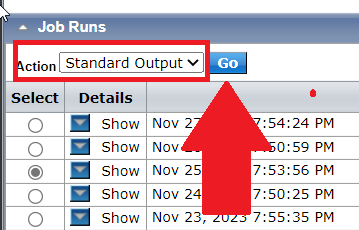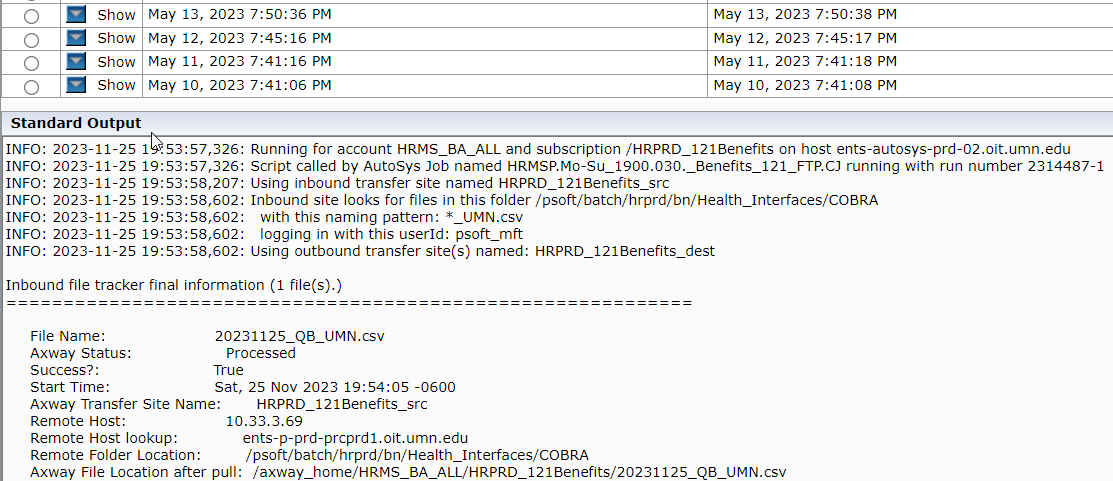Reviewing Logs for AutoSys Jobs that execute an Axway File Transfer#
This article is intended to give background technical information on how AutoSys and Axway interact and instruction on how to review logs so that business analysts can check on the status of a a file transfer.
An AutoSys job that is defined to execute an Axway file transfer is of the AutoSys job type called a Command job. It's called this because the purpose of this job type is not to execute, for example, a PeopleSoft job like a COBOL or App Engine on the PeopleSoft process scheduler servers, but instead schedule the running of a command-line command. Common examples of command jobs at the U are:
- Run scripts: examples:
- script to execute Axway file transfers
- script to send audit data to Splunk
- script to update AutoSys global variables daily
- script to backup job data to Google drive
- move, delete, or rename files on the PeopleSoft batch file server (/psoft/batch/xxprd/.....)
- sleep for n-seconds
In the case of using AutoSys to schedule & execute a file transfer via our Axway system, the command job executes a custom Python script written here at the University. The script uses Axway's delivered set of RESTful APIs to kick off the transfer & then monitor Axway logs to see how well the transfer is going. The script write information on its work to a log that can be reviewed by business analysts in the AutoSys website, instructions included in this article.
Note
When communicating with JST about a file transfer, please include the name of the relevant AutoSys job or provide the Axway Account & Subscription name.
Anatomy of the AutoSys Job to execute a Transfer#
All screenshots in the rest of this article are taken from the Quick View tab of the AutoSys administrative website.
An example AutoSys job that executes a an Axway file transfer:

In the screenshot above, 3 elements are highlighted:
1) Red outline: the job name 2) Green underline/arrow: the name of the Axway Account supplied as a runtime variable to the Python script 3) Purple underline/arrow: the name of the Axway Subscription
The Axway Account & Axway Subscription are the two pieces of information that uniquely identify a "transfer." Sometimes, staff and analysts use the words "subscription" and "transfer" to mean the same thing. In essence, a subscription/transfer just means the Axway setup required to tell Axway how to handle transferring a set of files. This includes defining where to pull the file from into Axway and where to send it out of Axway.
The full value of the Command field (sections of the command are underlined green/purple) basically tells the server to use Python to run a script with a set of run-time parameters (including Axway Account & Subscription).
Reviewing history of the Job Runs#
The script executed to accomplish the file transfer includes functionality to generate useful logs for review by business analysts when trying to find out how the file transfer proceeded on any given run of the AutoSys job. These logs provide a window into Axway - a system which to which analysts do not have access at this time.
The AutoSys job's history can be viewed from the Quick View tab by scrolling down to the Job Runs table.

This table provides you a listing of the start & end time of when the job was run in AutoSys. It tells you the Status of that run as well.
Success in the Status column means that the job successfully worked with Axway to execute the transfer. However, success can also mean that the transfer logged into the remote server, looked for the file it's supposed to grab, but saw that instead there were 0 files to pull down. If you want to override this behavior, contact JST and we can alter the command so that it will end in Failure if it finds zero files.
Failure in the Status column means that either AutoSys couldn't work well with Axway to accomplish the file transfer, or more likely, that Axway hit a snag when trying to transfer file(s).
Reviewing Logs for a Job Run#
Whether the job ended in Success or Failure, the logs can be useful. The logs tell you what the transfer was attempting to do and how that went. It logs information about each file that was successfully pulled into Axway (Inbound) and pushed back out (Outbound) to its final resting place.
To view the logs, click the radio button to select the Job Run you care to review.

Then, set the Action drop-down to Standard Output and click the Go button next to the field.

After clicking Go, then scroll down in the Quick View page to below the Job Runs section to the Standard Output section, which will now display the Standard Output from the execution of the command during the run of the AutoSys job you chose to review. In other words, the logs will display.

Understanding the Log (aka Standard Output)#
The log will tell you identifying information on the execution of the Axway subscription that can be useful when troubleshooting or communicating with JST about a particular transfer.
If any file(s) where transferred during the execution of the job, then the log will display information about the file as it came into Axway (Inbound) followed by information about the same file(s) as it left Axway (Outbound). Most file transfers are a simple two-way: file(s) in to Axway and back out. However, sometimes an Axway subscription is set up only to pull a file into Axway. This can be the case when you need a file to be put on to Axway so that some external trading partner can login to Axway and pull down the file when ready, for example. Other times, the Axway subscription can be set up to send out the file(s) to more than one destination.